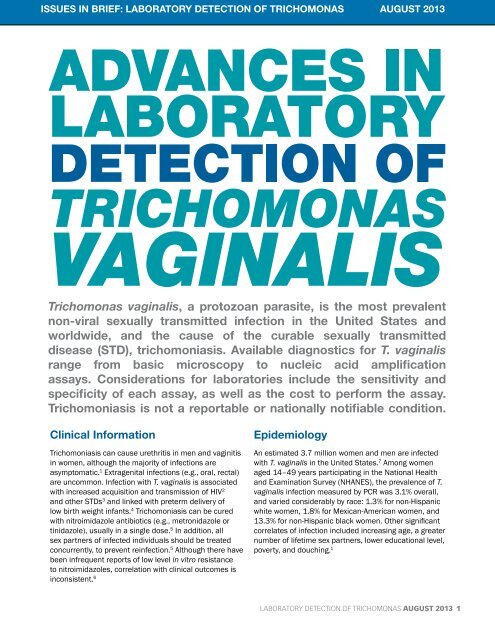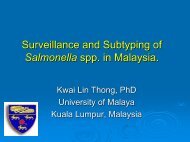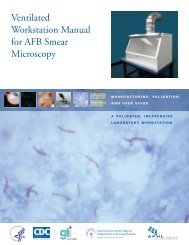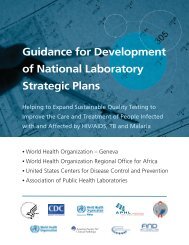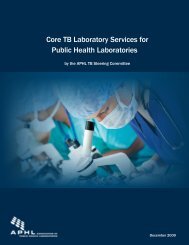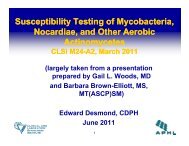Advances in Laboratory Detection of Trichomonas vaginalis
Advances in Laboratory Detection of Trichomonas vaginalis
Advances in Laboratory Detection of Trichomonas vaginalis
You also want an ePaper? Increase the reach of your titles
YUMPU automatically turns print PDFs into web optimized ePapers that Google loves.
Issues <strong>in</strong> Brief: <strong>Laboratory</strong> <strong>Detection</strong> <strong>of</strong> <strong>Trichomonas</strong> August 2013<br />
<strong>Trichomonas</strong> vag<strong>in</strong>alis, a protozoan parasite, is the most prevalent<br />
non-viral sexually transmitted <strong>in</strong>fection <strong>in</strong> the United States and<br />
worldwide, and the cause <strong>of</strong> the curable sexually transmitted<br />
disease (STD), trichomoniasis. Available diagnostics for T. vag<strong>in</strong>alis<br />
range from basic microscopy to nucleic acid amplification<br />
assays. Considerations for laboratories <strong>in</strong>clude the sensitivity and<br />
specificity <strong>of</strong> each assay, as well as the cost to perform the assay.<br />
Trichomoniasis is not a reportable or nationally notifiable condition.<br />
Cl<strong>in</strong>ical Information<br />
Trichomoniasis can cause urethritis <strong>in</strong> men and vag<strong>in</strong>itis<br />
<strong>in</strong> women, although the majority <strong>of</strong> <strong>in</strong>fections are<br />
asymptomatic. 1 Extragenital <strong>in</strong>fections (e.g., oral, rectal)<br />
are uncommon. Infection with T. vag<strong>in</strong>alis is associated<br />
with <strong>in</strong>creased acquisition and transmission <strong>of</strong> HIV 2<br />
and other STDs 3 and l<strong>in</strong>ked with preterm delivery <strong>of</strong><br />
low birth weight <strong>in</strong>fants. 4 Trichomoniasis can be cured<br />
with nitroimidazole antibiotics (e.g., metronidazole or<br />
t<strong>in</strong>idazole), usually <strong>in</strong> a s<strong>in</strong>gle dose. 5 In addition, all<br />
sex partners <strong>of</strong> <strong>in</strong>fected <strong>in</strong>dividuals should be treated<br />
concurrently, to prevent re<strong>in</strong>fection. 5 Although there have<br />
been <strong>in</strong>frequent reports <strong>of</strong> low level <strong>in</strong> vitro resistance<br />
to nitroimidazoles, correlation with cl<strong>in</strong>ical outcomes is<br />
<strong>in</strong>consistent. 6<br />
Epidemiology<br />
An estimated 3.7 million women and men are <strong>in</strong>fected<br />
with T. vag<strong>in</strong>alis <strong>in</strong> the United States. 7 Among women<br />
aged 14–49 years participat<strong>in</strong>g <strong>in</strong> the National Health<br />
and Exam<strong>in</strong>ation Survey (NHANES), the prevalence <strong>of</strong> T.<br />
vag<strong>in</strong>alis <strong>in</strong>fection measured by PCR was 3.1% overall,<br />
and varied considerably by race: 1.3% for non-Hispanic<br />
white women, 1.8% for Mexican-American women, and<br />
13.3% for non-Hispanic black women. Other significant<br />
correlates <strong>of</strong> <strong>in</strong>fection <strong>in</strong>cluded <strong>in</strong>creas<strong>in</strong>g age, a greater<br />
number <strong>of</strong> lifetime sex partners, lower educational level,<br />
poverty, and douch<strong>in</strong>g. 1<br />
<strong>Laboratory</strong> <strong>Detection</strong> <strong>of</strong> <strong>Trichomonas</strong> August 2013 1
Diagnostic Methods<br />
The traditional diagnostic method for trichomoniasis has<br />
been wet mount with microscopic visualization <strong>of</strong> motile<br />
T. vag<strong>in</strong>alis parasites on slide preparations from vag<strong>in</strong>al<br />
or urethral secretions. Ideally, specimens should be<br />
exam<strong>in</strong>ed with<strong>in</strong> 10 m<strong>in</strong>utes to observe motile parasites,<br />
which are diagnostic. Wet mount is an <strong>in</strong>expensive<br />
diagnostic test; however, sensitivity is estimated at<br />
51-65%, and varies based on the <strong>in</strong>dividual perform<strong>in</strong>g<br />
the test and how promptly the slide is <strong>in</strong>terpreted. 8,9<br />
Culture has been considered the gold standard<br />
for diagnosis <strong>of</strong> trichomoniasis with a specificity<br />
approach<strong>in</strong>g 100%, but it is not widely used and<br />
its sensitivity can be as low as 75–96%. 8,9 Cl<strong>in</strong>ical<br />
specimens can be <strong>in</strong>oculated <strong>in</strong>to transport systems<br />
such as Amies gel medium to ma<strong>in</strong>ta<strong>in</strong> viability for up<br />
to 24 hours at room temperature. 10 Culture systems<br />
such as InPouch TV (BioMed Diagnostics, San Jose, CA)<br />
allow for direct <strong>in</strong>oculation, culture and microscopic<br />
exam<strong>in</strong>ation. Additionally, these systems can be used<br />
to transport specimens after <strong>in</strong>oculation. Such systems<br />
are useful when immediate transportation <strong>of</strong> specimens<br />
to the laboratory is not available. The specimen should<br />
be <strong>in</strong>oculated as soon as possible (with<strong>in</strong> an hour <strong>of</strong><br />
collection) to ma<strong>in</strong>ta<strong>in</strong> viability <strong>of</strong> the organism.<br />
Neither conventional nor liquid-based Papanicolau (Pap)<br />
smears are suitable for rout<strong>in</strong>e screen<strong>in</strong>g or diagnosis<br />
<strong>of</strong> T. vag<strong>in</strong>alis, because sensitivity is poor; <strong>in</strong> addition,<br />
positive predictive value is low <strong>in</strong> sett<strong>in</strong>gs where the<br />
prevalence <strong>of</strong> <strong>in</strong>fection is low. 11<br />
The OSOM (formerly Xenostrip) <strong>Trichomonas</strong> Rapid<br />
Test (Sekisui Diagnostics, Fram<strong>in</strong>gham, MA) is an<br />
immunochromatographic capillary-flow enzyme<br />
immunoassay dipstick test and the only rapid antigen<br />
test commercially available <strong>in</strong> the US. It is performed<br />
on vag<strong>in</strong>al secretions with results available with<strong>in</strong><br />
10 m<strong>in</strong>utes. This po<strong>in</strong>t-<strong>of</strong>-care test is FDA-cleared for<br />
females and CLIA waived. Test specifications <strong>in</strong>clude<br />
sensitivity 82–95% and specificity 97–100%. 8,12<br />
The Affirm VPIII Microbial Identification Test (Becton<br />
Dick<strong>in</strong>son, Frankl<strong>in</strong> Lakes, NJ) is an FDA-cleared nucleic<br />
acid probe test for the diagnosis <strong>of</strong> three causes <strong>of</strong><br />
female vag<strong>in</strong>itis: T. vag<strong>in</strong>alis, Gardnerella vag<strong>in</strong>alis and<br />
Candida albicans. Sensitivity for T. vag<strong>in</strong>alis is 63%<br />
and specificity 99.9%. 13 This is considered a same-day<br />
test as it produces results <strong>in</strong> 45 m<strong>in</strong>utes; however, it is<br />
characterized as a CLIA moderate complexity test.<br />
Nucleic acid amplification tests (NAATs) are the most<br />
sensitive tests available for detection <strong>of</strong> T. vag<strong>in</strong>alis. The<br />
APTIMA <strong>Trichomonas</strong> vag<strong>in</strong>alis Assay (Hologic Gen-Probe,<br />
San Diego, CA) was FDA-cleared <strong>in</strong> 2011 for use with<br />
ur<strong>in</strong>e, endocervical and vag<strong>in</strong>al swabs, and endocervical<br />
specimens collected <strong>in</strong> the Hologic PreserveCyt solution<br />
(Th<strong>in</strong>Prep) from females only. Sensitivity is 95–100%<br />
and specificity is also 95–100%. 8, 13, 14 The BD ProbeTec<br />
<strong>Trichomonas</strong> Vag<strong>in</strong>alis Q x Amplified DNA Assay (Becton<br />
Dick<strong>in</strong>son, Frankl<strong>in</strong> Lakes, NJ) launched <strong>in</strong> Europe (EU<br />
cleared) <strong>in</strong> 2012, but is not FDA-cleared <strong>in</strong> the United<br />
States at this time.<br />
Diagnosis <strong>of</strong> T. vag<strong>in</strong>alis <strong>in</strong> men has been challeng<strong>in</strong>g<br />
given the low sensitivity <strong>of</strong> microscopy and lack <strong>of</strong><br />
FDA clearance to date for any NAATs or po<strong>in</strong>t-<strong>of</strong>-care<br />
tests for use with male specimens. Some laboratories<br />
have verified the performance characteristics <strong>of</strong> NAATs<br />
through a validation process for male ur<strong>in</strong>e specimens<br />
or penile-meatal swabs. Culture <strong>of</strong> ur<strong>in</strong>e, semen, and/or<br />
urethral swabs may be other diagnostic options for men.<br />
Screen<strong>in</strong>g and Treatment<br />
Current recommendations for T. vag<strong>in</strong>alis test<strong>in</strong>g<br />
and screen<strong>in</strong>g, along with detailed cl<strong>in</strong>ical treatment<br />
recommendations, can be found <strong>in</strong> CDC’s STD Treatment<br />
Guidel<strong>in</strong>es, available onl<strong>in</strong>e at:<br />
http://www.cdc.gov/std/treatment<br />
2 APHL Public Health <strong>Laboratory</strong> Issues <strong>in</strong> Brief
Table 1: Overview and characteristics <strong>of</strong> diagnostic assays for <strong>Trichomonas</strong> vag<strong>in</strong>alis*<br />
Diagnostic Test Technique Time to<br />
Result<br />
Specimen Sensitivity Specificity Comments<br />
Wet mount<br />
Microscopic<br />
visualization<br />
M<strong>in</strong>utes<br />
Vag<strong>in</strong>al or urethral<br />
discharge<br />
51–65% up to 100%<br />
Inexpensive; techniciandependent<br />
Culture Culture media 24–120 hours<br />
Vag<strong>in</strong>al or urethral<br />
swab<br />
75–96% up to 100%<br />
Considered diagnostic<br />
gold standard <strong>in</strong> the<br />
past<br />
OSOM<br />
<strong>Trichomonas</strong><br />
Rapid Test<br />
Immunochrom<br />
atographic<br />
capillaryflow<br />
enzyme<br />
immunoassay<br />
dipstick<br />
10 m<strong>in</strong>utes<br />
Vag<strong>in</strong>al swabs or<br />
sal<strong>in</strong>e for wet mount<br />
82–95% 97–100%<br />
CLIA-waived for females;<br />
can be used at the<br />
po<strong>in</strong>t-<strong>of</strong>-care<br />
Affirm VPIII<br />
Microbial<br />
Identification<br />
Test<br />
Nucleic acid<br />
probe test<br />
45 m<strong>in</strong>utes Vag<strong>in</strong>al swabs 63% 99.9%<br />
Moderately complex<br />
same-day test; FDAcleared<br />
for use with<br />
specimens from<br />
females; also detects<br />
Gardnerella vag<strong>in</strong>alis<br />
and Candida albicans<br />
APTIMA<br />
<strong>Trichomonas</strong><br />
vag<strong>in</strong>alis Assay<br />
Transcription<br />
Mediated<br />
Amplification<br />
(TMA)<br />
Hours<br />
Ur<strong>in</strong>e specimens,<br />
endocervical and<br />
vag<strong>in</strong>al swabs, and<br />
specimens collected<br />
<strong>in</strong> PreservCyt<br />
Solution<br />
95–100% 95–100%<br />
NAATs are the most<br />
sensitive tests; FDAcleared<br />
for use with<br />
specimens from<br />
symptomatic or<br />
asymptomatic females<br />
BD ProbeTec<br />
<strong>Trichomonas</strong><br />
vag<strong>in</strong>alis Q x<br />
Amplified DNA<br />
Assay<br />
Strand<br />
Displacement<br />
Amplification<br />
(SDA)<br />
Hours<br />
Not an FDA-cleared product<br />
Variety <strong>of</strong> female<br />
specimens have been<br />
tested<br />
PCR<br />
Polymerase<br />
Cha<strong>in</strong><br />
Reaction<br />
Hours<br />
No FDA-cleared kit<br />
Variety <strong>of</strong> male and<br />
female specimens have<br />
been tested<br />
*Ranges <strong>of</strong> sensitivities and specificities were summarized for multiple specimen types and <strong>in</strong>clude comparisons to multiple methods,<br />
based on published data (i.e., unpublished data from package <strong>in</strong>serts were not <strong>in</strong>cluded).<br />
<strong>Laboratory</strong> <strong>Detection</strong> <strong>of</strong> <strong>Trichomonas</strong> August 2013 3
<strong>Trichomonas</strong> vag<strong>in</strong>alis Test<strong>in</strong>g <strong>in</strong> Public Health Laboratories, 2010<br />
The Association <strong>of</strong> Public Health Laboratories and the Centers for Disease Prevention and Control fielded<br />
an onl<strong>in</strong>e survey <strong>in</strong> 2011 to characterize the role <strong>of</strong> public health laboratories (PHLs) <strong>in</strong> STD prevention.<br />
The objective <strong>of</strong> this survey was to determ<strong>in</strong>e current STD test<strong>in</strong>g capabilities and capacities <strong>of</strong> state and<br />
local PHLs over the period <strong>of</strong> January 1, 2010–December 31, 2010. The survey aimed to gather data from<br />
96 state and local public health laboratories with<strong>in</strong> the United States on overall capacities and capabilities<br />
as well disease-specific <strong>in</strong>formation. Of note, the first NAAT for T. vag<strong>in</strong>alis was FDA-cleared <strong>in</strong> 2011 and<br />
was not assessed <strong>in</strong> this survey.<br />
As <strong>of</strong> 2010, the capability <strong>of</strong> test<strong>in</strong>g for <strong>Trichomonas</strong> vag<strong>in</strong>alis was limited <strong>in</strong> public health laboratories.<br />
Of the 60 state and local PHLs that responded to T. vag<strong>in</strong>alis specific questions <strong>in</strong> the survey, 12 (20%)<br />
provided <strong>in</strong>-house test<strong>in</strong>g for T. vag<strong>in</strong>alis. Nearly all <strong>of</strong> the PHLs provid<strong>in</strong>g T. vag<strong>in</strong>alis test<strong>in</strong>g were local<br />
PHLs with only one state PHL provid<strong>in</strong>g <strong>in</strong>-house test<strong>in</strong>g. Two local PHLs referred test<strong>in</strong>g outside <strong>of</strong> the PHL<br />
system and the rema<strong>in</strong><strong>in</strong>g 47 PHLs did not provide any type <strong>of</strong> <strong>in</strong>-house test<strong>in</strong>g for T. vag<strong>in</strong>alis.<br />
Of the 12 laboratories that did provide <strong>in</strong>-house test<strong>in</strong>g, five provided culture (four used InPouch TV and<br />
one used Diamond broth) and 10 provided wet mount test<strong>in</strong>g services. Other exist<strong>in</strong>g diagnostic tests such<br />
as the Affirm VPIII, PCR and Xenostrip (now OSOM) were unavailable at these PHLs.<br />
Of the two local PHLs who referred test<strong>in</strong>g, culture, wet mount, Affirm VPIII, PCR and Xenostrip (now OSOM)<br />
were listed as test<strong>in</strong>g services that could be sent out <strong>of</strong> the PHL system.<br />
Of the 12 PHLs who provide <strong>in</strong>-house test<strong>in</strong>g, 10 reported test volume data. At these laboratories <strong>in</strong> 2010,<br />
a total <strong>of</strong> 9,424 specimens were tested with 691 (7.3%) specimens reported as positive for T. vag<strong>in</strong>alis.<br />
4 APHL Public Health <strong>Laboratory</strong> Issues <strong>in</strong> Brief
REFERENCES<br />
1. Sutton M, Sternberg M, Koumans EH, McQuillan G, Berman S, Markowitz L. The prevalence <strong>of</strong><br />
<strong>Trichomonas</strong> vag<strong>in</strong>alis <strong>in</strong>fection among reproductive-age women <strong>in</strong> the United States, 2001-2004. Cl<strong>in</strong><br />
Infect Dis 2007;45(10):1319-26.<br />
2. Mavedzenge SN, Pol BV, Cheng H, Montgomery ET, Blanchard K, de Bruyn G, et al. Epidemiological<br />
synergy <strong>of</strong> <strong>Trichomonas</strong> vag<strong>in</strong>alis and HIV <strong>in</strong> Zimbabwean and South African women. Sex Transm Dis<br />
2010;37(7):460-6.<br />
3. Allsworth JE, Ratner JA, Peipert JF. Trichomoniasis and other sexually transmitted <strong>in</strong>fections: results from<br />
the 2001-2004 National Health and Nutrition Exam<strong>in</strong>ation Surveys. Sex Transm Dis 2009;36(12):738-44.<br />
4. Cotch MF, Pastorek JG, 2nd, Nugent RP, Hillier SL, Gibbs RS, Mart<strong>in</strong> DH, et al. <strong>Trichomonas</strong> vag<strong>in</strong>alis<br />
associated with low birth weight and preterm delivery. The Vag<strong>in</strong>al Infections and Prematurity Study Group.<br />
Sex Transm Dis 1997;24(6):353-60.<br />
5. Workowski KA, Berman S, Centers for Disease Control and Prevention. Sexually transmitted diseases<br />
treatment guidel<strong>in</strong>es, 2010. MMWR Recomm Rep 2010;59(RR-12):1-110.<br />
6. Kirkcaldy RD, Augost<strong>in</strong>i P, Asbel LE, Bernste<strong>in</strong> KT, Kerani RP, Mettenbr<strong>in</strong>k CJ, et al. <strong>Trichomonas</strong> vag<strong>in</strong>alis<br />
antimicrobial drug resistance <strong>in</strong> 6 US cities, STD Surveillance Network, 2009-2010. Emerg Infect Dis<br />
2012;18(6):939-43.<br />
7. Satterwhite CL, Torrone E, Meites E, Dunne EF, Mahajan R, Ocfemia MC, et al. Sexually Transmitted<br />
Infections Among US Women and Men: Prevalence and Incidence Estimates, 2008. Sex Transm Dis<br />
2013;40(3):187-93.<br />
8. Huppert JS, Mortensen JE, Reed JL, Kahn JA, Rich KD, Miller WC, et al. Rapid antigen test<strong>in</strong>g compares<br />
favorably with transcription-mediated amplification assay for the detection <strong>of</strong> <strong>Trichomonas</strong> vag<strong>in</strong>alis <strong>in</strong><br />
young women. Cl<strong>in</strong> Infect Dis 2007;45(2):194-8.<br />
9. Nye MB, Schwebke JR, Body BA. Comparison <strong>of</strong> APTIMA <strong>Trichomonas</strong> vag<strong>in</strong>alis transcription-mediated<br />
amplification to wet mount microscopy, culture, and polymerase cha<strong>in</strong> reaction for diagnosis <strong>of</strong><br />
trichomoniasis <strong>in</strong> men and women. Am J Obstet Gynecol 2009;200(2):188 e1-7.<br />
10. Beverly AL, Venglarik M, Cotton B, Schwebke JR. Viability <strong>of</strong> <strong>Trichomonas</strong> vag<strong>in</strong>alis <strong>in</strong> transport medium. J<br />
Cl<strong>in</strong> Microbiol 1999;37(11):3749-50.<br />
11. Lobo TT, Feijo G, Carvalho SE, Costa PL, Chagas C, Xavier J, et al. A comparative evaluation <strong>of</strong> the<br />
Papanicolaou test for the diagnosis <strong>of</strong> trichomoniasis. Sex Transm Dis 2003;30(9):694-9.<br />
12. Campbell L, Woods V, Lloyd T, Elsayed S, Church DL. Evaluation <strong>of</strong> the OSOM <strong>Trichomonas</strong> rapid test<br />
versus wet preparation exam<strong>in</strong>ation for detection <strong>of</strong> <strong>Trichomonas</strong> vag<strong>in</strong>alis vag<strong>in</strong>itis <strong>in</strong> specimens from<br />
women with a low prevalence <strong>of</strong> <strong>in</strong>fection. J Cl<strong>in</strong> Microbiol 2008;46(10):3467-9.<br />
13. Andrea SB, Chap<strong>in</strong> KC. Comparison <strong>of</strong> Aptima <strong>Trichomonas</strong> vag<strong>in</strong>alis transcription-mediated amplification<br />
assay and BD affirm VPIII for detection <strong>of</strong> T. vag<strong>in</strong>alis <strong>in</strong> symptomatic women: performance parameters<br />
and epidemiological implications. J Cl<strong>in</strong> Microbiol 2011;49(3):866-9.<br />
14. Schwebke JR, Hobbs MM, Taylor SN, Seña AC, Catania MG, We<strong>in</strong>baum BS, et al. Molecular test<strong>in</strong>g<br />
for <strong>Trichomonas</strong> vag<strong>in</strong>alis <strong>in</strong> women: results from a prospective U.S. cl<strong>in</strong>ical trial. J Cl<strong>in</strong> Microbiol<br />
2011;49(12):4106-11.<br />
<strong>Laboratory</strong> <strong>Detection</strong> <strong>of</strong> <strong>Trichomonas</strong> August 2013 5
Association <strong>of</strong> Public Health Laboratories<br />
This publication was 100% f<strong>in</strong>anced by federal funds.<br />
The total amount <strong>of</strong> fund<strong>in</strong>g received for the STD Program is $68,023.<br />
This Brief was supported by Cooperative Agreement # U60HM000803 from CDC. Its contents are<br />
solely the responsibility <strong>of</strong> the authors and do not necessarily represent the <strong>of</strong>ficial views <strong>of</strong> CDC.<br />
8515 Georgia Avenue, Suite 700<br />
Silver Spr<strong>in</strong>g, MD 20910<br />
Phone: 240.485.2745<br />
Fax: 240.485.2700<br />
Web: www.aphl.org


